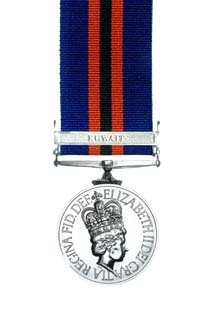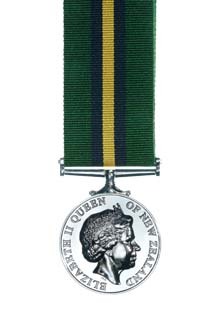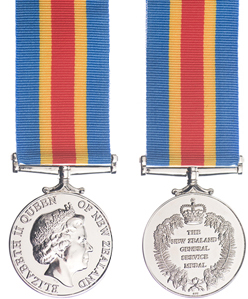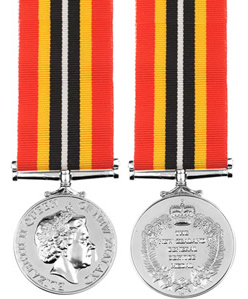
The Australian Active Service Medal (AASM) is an Australian military decoration. It was authorised on 13 September 1988 to recognise prescribed service in "warlike" operations, backdated to February 1975. It is awarded with a clasp to denote the prescribed operation and subsequent awards of the medal are made in the form of additional clasps. In 2012, it was announced that the medal would no longer be issued for future operations, with the AASM and the Australian Service Medal being replaced by the Australian Operational Service Medal.
Prior to 1946 the New Zealand armed forces received honours of the United Kingdom, including military decorations and campaign medals. Since the end of World War 2 there have been constant moves towards an independent New Zealand honours system. This has resulted in a new system of New Zealand honours, gallantry and bravery awards, and campaign medals.

The New Zealand General Service Medal 1992 (Warlike) is a New Zealand campaign medal, authorised in 1992, for award to New Zealanders who have served in warlike operations for which no separate New Zealand or British Commonwealth campaign medal was issued.

The New Zealand General Service Medal 2002 was a New Zealand campaign medal for service in the Solomon Islands. The medal was awarded for service during Operation Purple Haze 1 and 2, Operation Zephyr, and the International Peace Monitoring Team from 2000 to 2002 and with the Regional Assistance Mission to Solomon Islands (RAMSI) from 2003 to 2013.

The Operational Service Medal for Sierra Leone is a campaign medal established in 2000 by the Ministry of Defence of the United Kingdom for participation in the British military intervention during and after the Sierra Leone Civil War, from May 2000 to July 2002.

The Operational Service Medal for Afghanistan is a campaign medal previously awarded by the Ministry of Defence of the United Kingdom for service by British Armed Forces personnel in support of the post-2001 Afghan War.

The Operational Service Medal for the Democratic Republic of the Congo is a British armed forces campaign medal, awarded mostly to military personnel who served between 14 June and 10 September 2003 on Operation Coral.

The Vietnam Medal was a joint Australian and New Zealand campaign medal awarded for service in the Vietnam War.

The New Zealand General Service Medal 1992 (Non-Warlike) is a New Zealand campaign medal, authorised in 1992, for award to New Zealanders who have served in peacekeeping operations for which no separate UN medal was issued.

The Cadet Forces Medal is awarded to recognise long and efficient service by Commissioned Officers and non commissioned adult instructors of the UK Cadet Forces: The Army Cadet Force, the Air Training Corps, the Sea Cadets and Combined Cadet Force, and Commissioned Officers of the New Zealand Cadet Forces. Authorised by a Royal warrant it is awarded for 12 years service or when commissioned. Additional clasps are issued for every 8 years additional service in New Zealand & for 6 additional years in the UK.

The New Zealand General Service Medal 2002 (Korea) is a New Zealand campaign medal for service in Korea. The New Zealand General Service Medal 2002 was established by royal warrant to recognize service since 2000. The NZGSM 2002 (Korea) was authorized by regulation on 5 September 2008. To qualify for this medal personnel must serve thirty days in the Republic of Korea with the United Nations Command Military Armistice Commission (UNCMAC) or the United Nations Command Honour Guard Company. Only service since 1 January 2001 qualifies. This medal replaces the award of the New Zealand General Service Medal 1992 (Non-Warlike) with the Korea 1958-2000 clasp.

The New Zealand General Service Medal 2002 (Timor-Leste) is a New Zealand campaign medal for service in Timor-Leste during and after the 2006 East Timorese crisis between 28 April 2006 and 31 December 2012.

The New Zealand Distinguished Service Decoration (DSD) was instituted by Royal Warrant as a New Zealand Royal Honour in 2007 to recognise distinguished military service, by regular, territorial and reserve members of the New Zealand Defence Force. Until 1995, this type of service was recognised by awards of the British Empire Medal. After the change to a totally New Zealand Honours system in 1996, these Commonwealth awards were not available to be awarded to New Zealand military personnel.

The New Zealand Special Service Medal (NZSSM) was established by royal warrant by Elizabeth II, Queen of New Zealand on 23 July 2002. The medal serves to recognize military service that would not otherwise be recognized by a Campaign medal.

The Australian Operational Service Medal is a campaign medal established on 22 May 2012 to recognise service by Australian Defence Force (ADF) personnel on designated hazardous operations. It may also be awarded to civilians who serve alongside the ADF on designated operations under specific conditions.

The New Zealand General Service Medal 2002 (Counter-Piracy) is a New Zealand campaign medal for service in counter-piracy operations in an area centred on the Arabian Sea. The New Zealand General Service Medal 2002 was established by royal warrant to recognize service since 2000. The NZGSM 2002 (Counter-Piracy) was authorized by regulation on 27 March 2015. To qualify for this medal personnel must serve thirty days in an operational area as a member of a New Zealand Government contribution to a force undertaking counter-piracy operations. Only service on or after 1 January 2009 qualifies. Outside the Arabian Sea other areas of operation include the Gulf of Aden, the Western Indian Ocean, and off the coasts of Somalia, Yemen, and Oman. The earliest large deployment of New Zealand Forces was when HMNZS Te Mana served with Combined Task Force 151 and Operation Ocean Shield from November 2013 to February 2014.

The New Zealand General Service Medal 2002 is a New Zealand campaign medal for service in the land territory, airspace, and territorial sea of the country of Iraq since 4 November 2014.

The New Zealand General Service Medal 2002 is a New Zealand campaign medal for service in the Middle East since 7 December 2014.

The Operational Service Medal Iraq and Syria or Operation Shader Medal is a British armed forces campaign medal, awarded mostly to military personnel who served in the operational area of, or in support of Operation Shader. The medal was first announced by former Defence Secretary, Sir Michael Fallon on 19 September 2017. It was first awarded, to service personnel, on 18 July 2018 in London by Defence Secretary Gavin Williamson. This Operational Service Medal is the first medal of the contemporary era to be awarded to individuals who served outside of the operational area, reflecting the changing nature of warfare.















